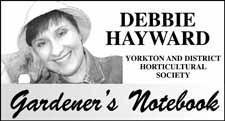Hasn't it been a busy month? We went from a heavy snowfall warning on April 30 to working out in our yards and having our plant sale on May 24! Thank you to everyone who helped to make the plant sale such a success: all our wonderful gardening customers who came and supported us; everyone who worked at the sale, from set-up to manning the tables to taking down at the end of the day; and to everyone who contributed lovely plants for the sale, with special thanks to those of you who don't belong to the group but so kindly donated plants: thank you all for a great day!
I'll take this time to remind all Yorkton and District Horticultural Society members that our next meeting is on Wednesday, June 19, starting at 6:00 p.m. at Skinner's Garden Classics and Greenhouse. Please note the day, Wednesday, June 19. This is a members only (and significant other) meeting, and it's a potluck supper. If you have any questions about the evening, please call Liz at 782-2830. It's always a great time, so mark that date down and plan to attend!
And one more bit of housekeeping: hort club members, the bus tour to the Neepawa Lily Festival takes place on Saturday, July 20. If you are thinking of taking this road trip, please call Liz at 782-2830. After mid-June, if any seats on the bus are still available, the general public will be invited to join us, so don't miss out!
By now you have likely planted a portion of, if not all, your garden. Doesn't it feel good to be working with our plants again? I was glancing through Sweet Pea's garden books again, specifically, the "Vegetable" volume of the American Horticultural Society garden collection. There was a chapter called "Experienced Advice", and there was a cute "rule" for sowing peas, beans and corn: "one for the blackbird, one for the crow, one for the cutworm, and one to grow". In other words, sow more seeds than you think you actually need for your row. Something always happens, so it's good to have a few extra seeds in the row, just for insurance! I tend to get a little too cautious and over-seed, especially with carrots and beets, but if they are planted too thickly they don't do well at all, so try to find some moderation when you are sowing!
Once again, I planted my favorite variety of Swiss chard, "Bright Lights", and I read an interesting factoid about Swiss chard: that it is a favorite because it can take the heat that makes other veggies like spinach and lettuce bolt. I find it not only delicious but beautiful in the garden, so toss in a few Swiss chard seeds if you are still planting.
And here's something interesting about onions: did you know that the onion grows tops in cool weather, and forms bulbs in warm weather? Temperatures and the length of the days control the timing of your onion forming a bulb. Onion varieties are classified as "long-day" and "short-day", although most varieties grown in Canada are "long-day", needing about 14 to 16 hours of daylight. Who knew? I also read that onions are heavy feeders; probably most of us hardly glance at the sturdy onion once it is planted until it is time to harvest, but maybe we should pay a little extra attention to them, give them a little extra TLC, and enjoy an even more bountiful harvest! The onion is a great vegetable, so versatile and flavorful. The article that I read in Mom's book said that General Grant sent a dispatch to the war department saying that "I will not move my armies without onions." Imagine!
Good luck with your onions, and the rest of your garden planting! Have a great week, and be sure to wear a hat!




